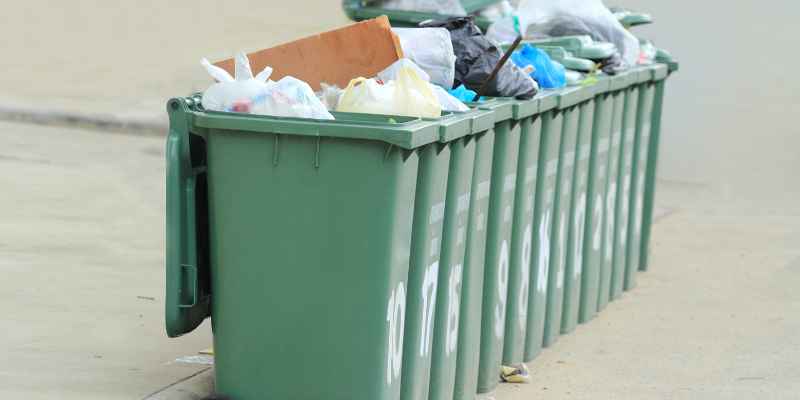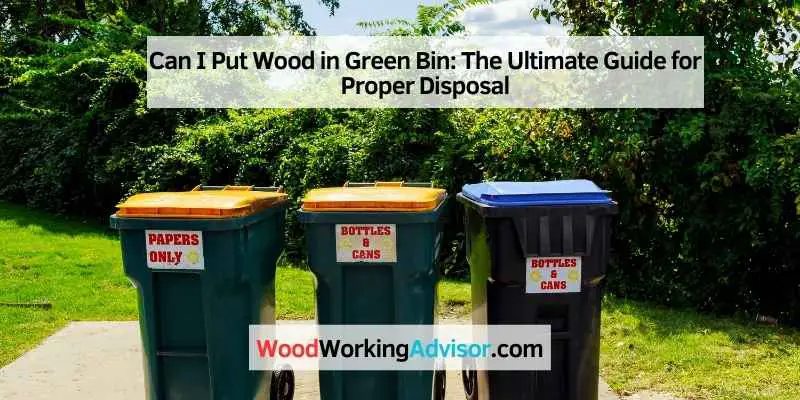Yes, you can put wood in the green bin. Wood is considered a green waste item.
When disposing of wood in the green bin, it’s essential to ensure that it is untreated and free from any paint, stains, or preservatives. By including wood in your green bin, you help in the recycling process, where it can be composted and turned into nutrient-rich soil for plants and gardens.
Green bins are designed to handle organic materials, including wood, effectively diverting waste from landfills and contributing to a more sustainable environment. Properly managing your wood waste in the green bin is a simple yet impactful way to support eco-friendly practices and reduce your carbon footprint. Remember to follow your local waste management guidelines to ensure you are disposing of wood properly in the green bin.
Understanding Green Bins
What Are Green Bins?
Green bins are a crucial component of waste management, designed specifically for organic waste, such as food scraps, yard trimmings, and other biodegradable materials. They are typically distinguishable by their green color and are aimed at diverting organic waste away from landfills, providing an environmentally friendly alternative for disposal.
Purpose Of Green Bins
The purpose of green bins is to promote sustainable waste management practices by reducing the amount of organic waste ending up in landfills. By segregating organic waste into green bins, communities can encourage composting and recycling, which leads to the production of nutrient-rich compost for use in agriculture and gardening. Ultimately, the goal is to lessen the environmental impact of organic waste while fostering a more sustainable and eco-friendly approach to waste disposal.
Accepted Materials In Green Bins
When it comes to the Accepted Materials in Green Bins, it’s essential to understand what can and cannot be placed in them.
Organic Waste
Green bins accept organic waste, such as food scraps and yard waste, to promote environmentally friendly disposal practices.
Food Scraps
Regarding food scraps, items like fruit peels and leftover meals can be safely disposed of in the green bin.
Yard Waste
Yard waste, including grass clippings and branches, is another accepted material that can go in the green bin for proper disposal.
Prohibited Items In Green Bins
When it comes to sorting your waste, it’s essential to know what items are allowed and what should never be placed in your green bin. Proper waste disposal is not only important for the environment, but it also helps with recycling efforts. In this blog post, we will focus on prohibited items for green bins.
Wood Products
Wood is a common material that people may have a question about when it comes to green bin disposal. However, putting wood products like furniture, lumber, or branches in your green bin is strictly prohibited.
Wood takes a longer time to decompose, and it can cause problems in the composting process, resulting in suboptimal compost quality. To properly dispose of wood, explore local options for recycling or reuse, or consider contacting local waste management agencies for guidance on proper disposal methods.
Hazardous Materials
Hazardous materials pose risks to both environmental and human health. Therefore, it is crucial to never include them in your green bin. These materials include, but are not limited to:
- Chemical products like pesticides, fertilizers, and herbicides
- Paint, paint thinners, and solvents
- Batteries and electronic waste
- Medications and medical waste
Improper disposal of hazardous materials can lead to contamination of the compost and ultimately harm the environment. Always follow local guidelines for safe disposal of hazardous materials, as these substances require specialized handling and proper disposal methods.
Wood Disposal Options
When it comes to disposing of wood waste, many people wonder whether it is acceptable to put wood in the green bin. Unfortunately, the answer is not a simple yes or no. The rules for wood disposal vary depending on where you live and the guidelines set by your local waste management authority. However, there are still several wood disposal options you can consider.
Alternatives For Wood Disposal
If you are unable to put wood in the green bin, don’t worry. There are alternative methods you can explore to dispose of your wood waste responsibly. Here are a few options to consider:
- Recycling: Check if there are any recycling programs or facilities in your area that accept wood waste. Some recycling centers have specific guidelines, such as only accepting untreated or unpainted wood.
- Reuse: If the wood is still in good condition, consider repurposing it for other projects or donating it to a local organization or community center.
- Composting: While not all types of wood are suitable for composting, certain untreated and unpainted wood scraps can be added to your compost pile. However, it’s important to ensure that the wood is free from any chemicals or contaminants that could harm your compost.
- Landfill: As a last resort, if none of the above options are available or feasible, you may have to dispose of the wood waste in a landfill. However, this should only be considered if all other environmentally-friendly options have been exhausted.
Approved Wood Waste Facilities
If your wood waste does not fit into any of the above alternatives, you may need to take it to an approved wood waste facility. These facilities specialize in properly disposing of and managing wood waste. To find a facility near you, contact your local waste management authority or search online for approved wood waste facilities in your area.
Remember, it’s essential to follow the guidelines and regulations set by your local waste management authority when it comes to wood disposal. By doing so, you can ensure that you are disposing of your wood waste in an environmentally-friendly and responsible manner.
Impact Of Wood In Green Bins
When wood is put in green bins, it can have detrimental effects on the environment.
- Wood takes longer to decompose compared to other organic materials.
- It can lead to increased methane emissions in landfills.
Contamination can occur when wood is improperly disposed of in green bins.
- Wood can attract pests like termites and ants.
- It can also contain chemicals or paint that are harmful to the environment.
Proper Disposal Methods For Wood

Wood should not be put in the green bin as it can contaminate organic waste. Proper disposal methods for wood include recycling, composting, or using it for mulch. Ensure to check with local waste management for specific guidelines on wood disposal.
When it comes to proper disposal methods for wood, it’s important to follow environmentally friendly practices to reduce waste and promote sustainability. Rather than simply tossing wood into the trash, it’s essential to consider composting or utilizing wood recycling programs.
Composting Wood
Composting wood not only reduces waste but also provides a natural fertilizer for gardens and plants. When composting wood, be sure to follow these simple steps:
- Start by breaking down the wood into smaller pieces. This helps speed up the composting process.
- Layer the wood pieces with other compostable materials such as grass clippings, leaves, and vegetable scraps.
- Keep the compost pile well-aerated by turning it regularly.
- Monitor the moisture levels and add water if needed. The ideal moisture range is between 40-60%.
- Allow the compost pile to decompose for several months, stirring occasionally, until the wood is fully broken down.
- Use the finished compost to enrich soil and promote healthy plant growth.
Utilizing Wood Recycling Programs
If composting is not a feasible option for you, consider utilizing wood recycling programs in your area. These programs are specifically designed to handle and process wood waste in an environmentally friendly manner. Here are a few steps to take when using wood recycling programs:
- Research local recycling centers or facilities that accept wood waste.
- Contact these centers to understand their requirements and drop-off procedures.
- Prepare the wood waste by removing any nails, screws, or other hardware.
- Transport the wood waste to the designated recycling facility.
- Follow any specific guidelines provided by the facility regarding sorting or separating different types of wood.
- Ensure that the wood waste is properly disposed of and recycled.
Community Guidelines And Regulations
Yes, you can put wood in the green bin, but it needs to be cut into smaller pieces that fit inside. Additionally, make sure the wood is untreated and free from any paint or chemicals. This is to ensure that the composting process can break down the wood effectively.
When it comes to proper waste disposal, it is important to understand the community guidelines and regulations in place. These guidelines help ensure that waste management is done in an efficient and environmentally-friendly manner. In this section, we will discuss the local green bin policies as well as the legal implications of improper disposal.
Local Green Bin Policies
Each community has its own set of regulations when it comes to using the green bin for waste disposal. It is essential to familiarize yourself with these policies to avoid any violations and potential fines. Here are some key aspects to consider:
- The types of materials that are allowed in the green bin
- Any restrictions on the size or weight of items
- Proper sorting and containment guidelines
- Collection schedules and guidelines for placing bins out for pick-up
It is important to follow these policies diligently to ensure the smooth operation of the waste management system in your community. By doing so, you contribute to a cleaner and more sustainable environment.
Legal Implications Of Improper Disposal
Improper disposal of wood or any other waste material can have legal implications and consequences. Disregarding the community guidelines and regulations can lead to fines imposed by local authorities. These fines are meant to discourage improper waste disposal and encourage compliance.
Moreover, improper disposal can damage the environment and harm wildlife. When waste, including wood, is not disposed of correctly, it can release harmful pollutants into the air, soil, and water sources. Such pollutants can have a severe impact on ecosystems and public health.
It is crucial to understand the potential legal consequences and environmental effects that improper wood disposal can have. By disposing of wood properly in the green bin, you not only adhere to the regulations but also contribute to the preservation of the environment for future generations.
Educational Outreach And Awareness
Community education plays a vital role in promoting responsible waste management practices. By increasing awareness and fostering a culture of sustainability, we can contribute to a healthier environment for future generations.
Educating Communities
Involving communities in educational programs helps create a shared understanding of recycling guidelines and the importance of proper waste disposal. Through workshops, seminars, and outreach events, individuals can learn about the impact of their actions on the environment.
Initiatives For Responsible Waste Management
- Implementing recycling campaigns to reduce contamination in green bins
- Collaborating with schools to teach students about environmental stewardship
- Providing resources and FAQs on the correct disposal of wood waste
- Engaging local businesses in sustainable practices to reduce landfill waste
This optimized blog post snippet conveys the importance of educational outreach and awareness in promoting responsible waste management, specifically focusing on the issue of wood disposal in green bins. It highlights initiatives and strategies aimed at educating communities and implementing sustainable practices for better environmental outcomes.

Frequently Asked Questions Of Can I Put Wood In Green Bin
Can You Put Wood In Any Of The Bins?
Yes, wood can be placed in the designated organic waste or yard waste bins.
Can You Put Wood In Compost Bin?
Yes, you can put small amounts of untreated wood in a compost bin. Break it into pieces for faster decomposition.
Can You Recycle Wood In Austin?
Yes, you can recycle wood in Austin.
Can You Put Sawdust In Green Bin?
Yes, sawdust can be put in the green bin as organic waste. It is compostable and helps in the decomposition process.
Conclusion
Remember, putting wood in your green bin can impact composting processes. Opt for proper disposal methods to prioritize sustainability. Separating wood waste ensures efficient recycling and reduces environmental harm. By being mindful of what goes in your green bin, you contribute to a greener future for all.
Make a conscious choice towards eco-friendly practices today.


